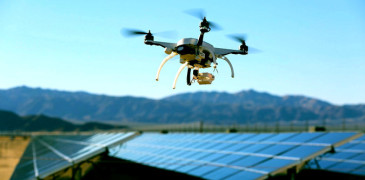
These drones can be used to examine smokestacks, wind turbines, power-lines and mounted solar panels without having workers scale these enormous structures; thus eliminating the danger they are putting these workers into. The drones are also able to zone in on small, hard to reach locations thanks to high powered cameras, making them potentially more effective at spotting damage than the human eye.
Consider the application uses by the developers of photovoltaic plants, like First Solar; it requires thousands of man hours to inspect and detect any damages or malfunctions on a routine basis and they also have to use handheld devices, which put them at risk for injury. Drones will be able to remotely navigate these sites, and through the use of specially designed thermal imagers, detect the malfunction panels, without endangering a single life.
Skycatch, a small startup drone company that is about a year old, has developed a drone design that is operating autonomously. The drone is guided by cameras, G.P.S and active sonar sensors, to move around construction sites to allow owners, site foremen and construction managers get a hard look at the progress of a site, without inhibiting the work currently going on. The system comes with a 100 pound box that is roughly two feet by two feet, and contains 10 power car batteries that double as 15 gigabyte storage devices. Once landed on this ‘platform’ the battery is automatically replaced and the data uploaded through cloud systems to its targeted destination, allowing for real time information feeds and updates.
Alan is serial entrepreneur, active angel investor, and a drone enthusiast. He co-founded DRONELIFE.com to address the emerging commercial market for drones and drone technology. Prior to DRONELIFE.com, Alan co-founded Where.com, ThinkingScreen Media, and Nurse.com. Recently, Alan has co-founded Crowditz.com, a leader in Equity Crowdfunding Data, Analytics, and Insights. Alan can be reached at alan(at)dronelife.com